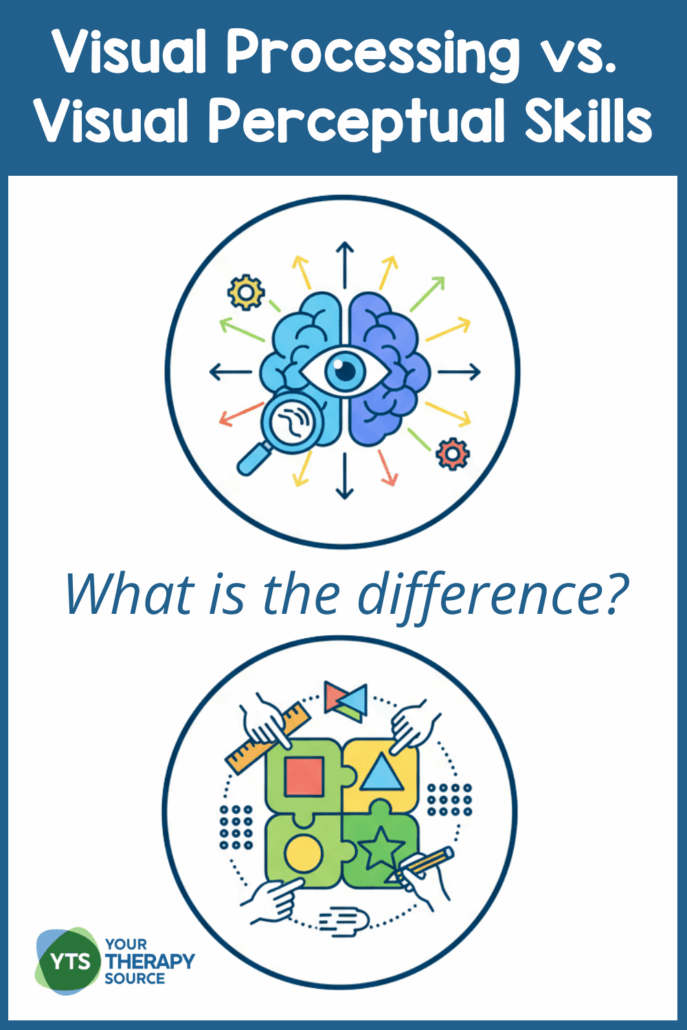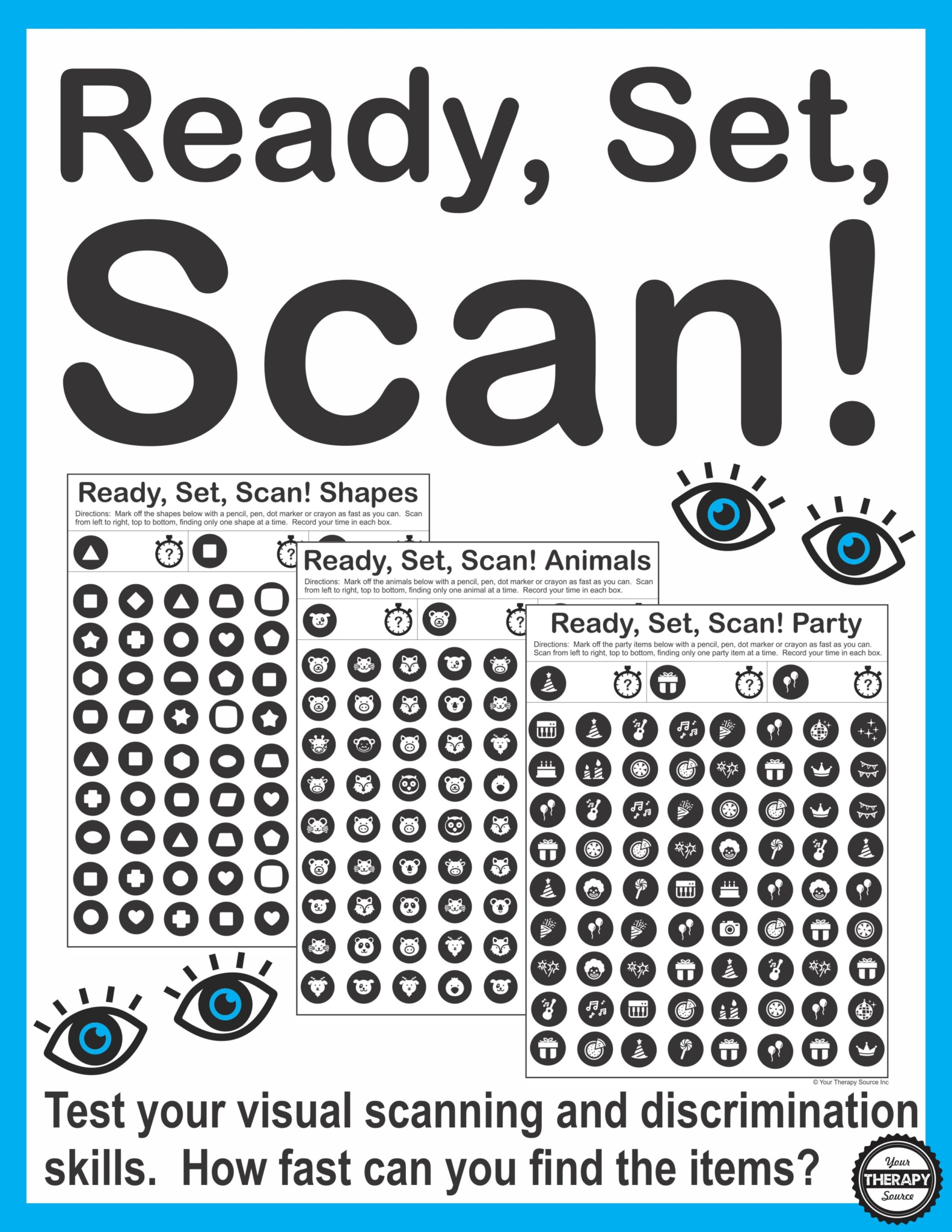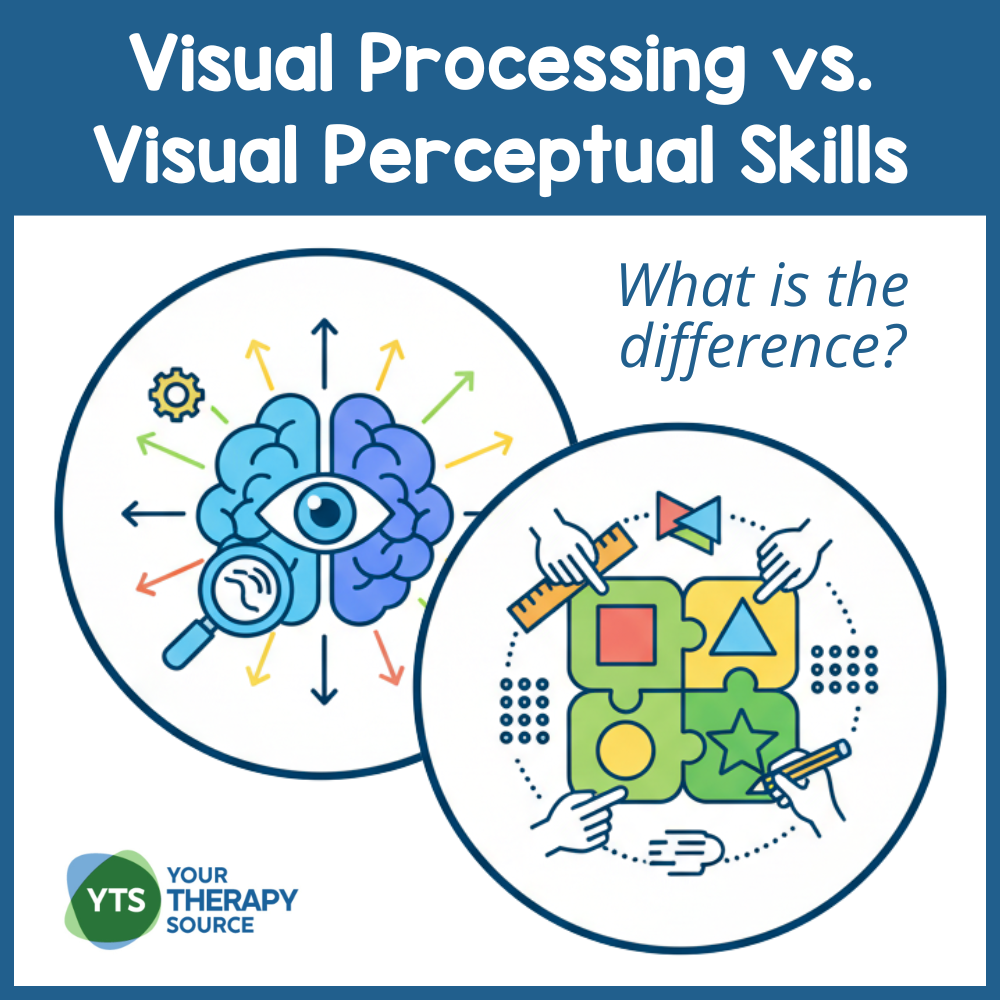Visual Processing and Visual Perceptual Skills: What’s the Difference?
Visual processing and visual perceptual skills are essential for learning, movement, and daily functioning, but they are not the same thing. Educators and therapists often use these terms interchangeably, yet they describe different parts of how the brain makes sense of what we see. Understanding this difference helps professionals identify challenges and support students more effectively.

What Is Visual Processing?
Visual processing refers to how the brain receives, organizes, and interprets visual information from the eyes. It begins when light enters the eyes and travels through the optic nerve to the visual cortex in the back of the brain. From there, different regions work together to identify colors, shapes, movement, and spatial relationships. Visual processing happens automatically and continuously, forming the foundation for how we see and understand our world.
When visual processing is strong:
- Students can quickly take in new visual information.
- They can track text while reading and copy from the board with ease.
- They respond appropriately to what they see, such as catching a ball or navigating a classroom.
When visual processing is weak:
- Students may have normal eyesight but still miss visual details.
- They may lose their place while reading, struggle to locate information on a page, or find busy environments overwhelming.
Visual processing acts like the hardware of the visual system, determining how efficiently the brain takes in and transfers visual information.

Ready, Set, Scan – Visual Scanning and Discrimination Activity
What Are Visual Perceptual Skills?
Visual perceptual skills are the specific mental abilities that help us interpret and use visual information. They are the “software programs” that allow us to give meaning to what we see.
These skills include:
- Visual discrimination: Noticing small differences in letters, shapes, or objects.
- Figure-ground perception: Finding an object in a busy background.
- Visual closure: Recognizing an image even when part is missing.
- Visual memory: Remembering what something looks like.
- Visual spatial relations: Understanding where things are in space, such as left, right, above, or below.
- Form constancy: Recognizing shapes or letters even when size or position changes.
- Visual sequencing: Remembering and reproducing visual patterns or letter order.
When visual perceptual skills are strong:
- Students can copy patterns, recall sight words, and organize their work on a page.
- They can find items quickly in a cluttered environment.
When these skills are weak:
- Students may reverse letters, skip words, or struggle to complete puzzles.
- They may find handwriting, spelling, and visual-motor activities difficult.
Visual Processing and Visual Perceptual Skills: How They Work Together
Visual processing and visual perceptual skills work together but serve different roles. Visual processing is how the brain takes in and manages visual information, while visual perceptual skills determine what the brain does with that information.
| Visual Processing | Visual Perceptual Skills |
|---|---|
| Receives visual input | Interprets and gives meaning |
| Automatic brain function | Learned cognitive skill |
| Hardware of the visual system | Software that organizes input |
| Example: noticing a red shape | Example: recognizing it’s a heart |
When either system is inefficient, learning and participation can be affected. A child may have strong visual acuity but still miss meaning, organization, or recall.
What Educators and Therapists Can Do to Help
1. Observe and Identify Early
Look for signs of visual difficulties that go beyond eyesight, such as letter reversals, skipping words, poor handwriting spacing, or fatigue during reading. Early observation helps determine whether further visual perceptual or visual processing assessment is needed.
2. Reduce Visual Overload
Simplify the environment. Use clear, uncluttered layouts, limit visual distractions on walls, and highlight key instructions with color or spacing.
3. Strengthen Visual Perceptual Skills
Provide structured practice using engaging activities:
- Visual discrimination and matching worksheets
- Mazes, hidden pictures, and “spot the difference” tasks
- Copying block patterns, tangrams, or design cards
- Sequencing games and memory matching cards
4. Integrate Movement
Link vision with motor activities to reinforce brain pathways. Try:
- Toss-and-catch games that involve tracking and timing
- Obstacle courses with directional cues
- Tracing and drawing on vertical surfaces to improve eye-hand coordination
5. Build Visual Memory
Encourage short visual memory games. Show a few pictures, cover them, and ask the student to recall what they saw. Repeat in short bursts to help the information stick.
6. Collaborate Across Disciplines
- Teachers can incorporate visual supports and simplify materials.
- Occupational therapists can assess and target visual perceptual skills.
- Physical therapists can integrate body-based tasks that reinforce eye-hand coordination.
- Speech-language pathologists can pair visuals with language comprehension.
- Special educators can reinforce generalization and big-picture understanding through structure and repetition.
Visual processing is how the brain takes in and organizes visual input. Visual perceptual skills are how the brain interprets and uses that input for learning, movement, and communication. When both systems work together smoothly, students can focus, read, write, and participate successfully. When there are challenges, targeted activities, environmental supports, and team collaboration can make a significant difference.



